The calendar showed April 9, 1970, when Paul McCartney gave a press conference in London, as part of the promotion of his first solo album, "McCartney", which was scheduled to be released on the 17th of the same month. The conversation revolved around the content of the record, until Paul was asked about the Beatles' plans for the immediate future. And that's where the megaton bomb went off. Without announcing the final breakup of the band, McCartney limited himself to saying that he was no longer a member of the band and that he had no intention of working with them again. He also referred to his non-existent relationship with the band's manager, Allen Klein, while ruling out the possibility of writing songs with John Lennon again. The shock was deafening.
The next day, the news was on the front pages of newspapers around the world. "The Daily Mirror" ran with the headline "Paul quits the Beatles" and a few hours later, several fans of the band, upset by the news, began to gather outside the Apple Corps offices in number 3 of Savile Row in the English capital, waiting for developments, but also for the official confirmation from the "beetles" company about whether the dissolution of the group was really true. What no one knew, apart from the band members and a few more trusted people, was that in essence the Beatles had ceased to exist - at least with their known line-up - since September 20, 1969, when Lennon had informed the other members that he wanted a "divorce" from the band.
But because at that time the band was renegotiating the terms of the contract with Capitol Records, Paul, George and Ringo asked John not to publicize his decision, which he did. We saw that within just seven months, the two leading figures of the "beetles" put themselves out of the group. But what were the root causes of the dissolution of the greatest edifice of modern music, the most important and most unique compositional "magical mystery tour" of the 20th century? These are exactly the reasons we will try to decipher in today's text, 51 years after the end credits on the unique journey of the legendary foursome from Liverpool, the one who left behind the ultimate musical legacy.
THE TOP BAND OF MODERN MUSIC

Let's start by stating the obvious, that the Beatles are the elegance that epitomized the harmony beyond the boundaries of rock and roll and R &B. They almost miraculously conquered the top artistically, commercially, culturally and spiritually in the decade. 60, when music had the power to change the world - or at least gave the impression that it could. They are without a doubt the most important band in the history of rock. Within a decade they unfolded their multifaceted talent and created some of the greatest masterpieces in the history of world music. They turned their ideas into an unprecedented musical adventure, exploring the combinations and creating not only art, but also a unique way of life and thinking.
They sought musical outlets, experimented and gave a new identity to complexity, "discovering" genius musical forms. They offered rock an inexhaustible wealth of chords and composed songs serving in a special and unsurpassed way the concept of melody. They were role models for the youth of the whole world, they conquered the USA in a few hours starting the famous British Invasion in 1964, they were introduced to drugs by Dylan and they mixed the musical currents of the time, ending up with an idiosyncratic and unincorporated pop, which was characterized by the poetry of the lyrics and the celebration of sounds and colors, embodying within it a magical lyricism the likes of which modern music has never experienced before.

Starting with "Please, please me" and ending with "Let it be", each of their LPs is a special kind of art in itself. The velvet approach to 60s tension was realized introspectively, but the result was full of direct messages that traveled like waves and swallowed everything in their path:love, the townspeople, rebellion, happiness, figures, images, denial, dreams, revolution, all these and more, crystal clear in the "strawberry fields" of an eternal wandering, which will enchant and inspire any free spirit who seeks the beauty of a charming impulsiveness. Their lyrics, from melancholic love songs to screams of anguish - their own and their generation's - are riveting and coexist harmoniously with the rhythms.
Even when they wanted to "fight" against their own image, now deeply influenced by the journey of India, the "atmosphere" of the Rishikesh and the teachings of the Maharishi, the technique of transcendental meditation passed cerebrally and emotionally into every chord of the masterpiece white album, from the atmospheric "Dear Prudence" to the angry "Revolution". The path followed by the Beatles invented a distinct culture, combined in a delightful and crystalline way the quintessence of musical perfection and the catalytic presence of constant evolution, mesmerizing and captivating their audience, through unexplored paths and techniques, sophisticated and complex orchestrations in an unprecedented sound environment.
When they felt that manipulation threatened them, they did not hesitate to stop live performances altogether and "self-exile" away from the reality of Beatlemania, seeking refuge in the intellect of a productive orgasm that brought with it mystical liberation and the most important artistic "monuments". of the 20th century. All tendencies were placed at their service, and in the end isolation met the greatest possible vindication. The dream era was identified with the Beatles, because they were the ones who brought it to life, approaching all forms of rock, from rock &roll, melodic ballads, blues, R&B and skiffle, to psychedelia, classical music, pop and hard rock, in a unique path of creative magic.
HOW MIRACLE TURNED INTO CONFLICT

McCartney and Lennon, the most genius songwriting and lyrical duo the world has ever known, were flanked by two great personalities, Harrison and Starr, who didn't just fill in the gaps, but offered their own energy and talent to the soul of the Beatles. . The "beetles" adorned countless treasures in their time, leaving behind unsurpassed lyrics and melodies. Their work is not only timeless, but valuable in every way. Their legacy will live forever as a blessed offering that will move, seduce, inspire and enchant every heart that seeks perfection. Because the Beatles were not just a band, but a miracle, the eternal exploration of the pentagram beyond all conventional logic.
But what happened and this miracle turned into an open conflict within the band, leading to its final breakup? First let's say that many different causes intersected, each of which opened cracks in the Beatles' edifice. When all of these were combined together, it became clear that there was no going back and that it was now just a matter of time before the barriers that had been so carefully "built", especially from 1966 onwards, were "broken". If we want to summarize in one sentence the most important causes that brought the end credits of "beetles", then we come to the following:Lennon's relationship with Yoko Ono, the dominant role that McCartney sought, the more and more compositions of Harrison that demanded his own "space" on the albums and the death of the group's manager, Brian Epstein.
1967, THE DEATH OF BRIAN EPSTEIN

All these causes, of course, have smaller ramifications, which we will mention below. Although considered by most to be the "flagship" of the Beatles' problems, Lennon's relationship with Yoko, the first event that destabilized the band, was precisely the loss of the man who had the unique talent of keeping the balance between the four members , the manager of the "beetles" from 1962 until his death in 1967, from an overdose of barbiturates, at the age of 32. The death of Brian Epstein created a huge void in the relationships of the "Fab Four", a void that not only was never filled, but led to another major cause of the breakup, the "war" between Lennon, Harrison and Starr on the one hand and McCartney on the other hand, for the successor in the management of the band.
I think two phrases are typical of Epstein's importance in the Beatles' career. One from McCartney:"If anyone was the fifth Beatle, it was Brian." And the other from Lennon:"I knew things in the group were already difficult, but when Brian left, I thought now we've fucked her." Before moving on to Lennon's "chapter", let's first open a small parenthesis to go back to 1964. That year, on their first US tour, the Beatles met Bob Dylan, at a time when for the first time in their lives they felt they were in danger of turning into a product ready to be manipulated. Dylan generously offered them a model they had never imagined before:fantastical imagery, a "kaleidoscopic" perception of music and a reconciliation with the idea of death.
1964, MEETING BOB DYLAN

His proposition was simple and specific:alcohol, drugs, trips and "speed". Dylan's influence was first seen in the band's lyrics. Harrison and Starr immediately fell head over heels for amphetamines, LSD, and marijuana, not really caring why. Lennon and McCartney, however, made an important turn in their lives, leading their genius into unexplored harmonic corridors and carrying out their own revolution against the revolution, against the myth in which they felt trapped as the Beatles. Both were left to introspection resulting in the creation of true masterpieces. But at the same time, they were now "open", exposed and vulnerable to influences starting from their childhood in small-town Liverpool and reaching as far as beatnik philosophy, German existentialists and surrealism.
We close the parenthesis and return to 1967, the year the monumental "Sgt Pepper's Lonely Hearts Club Band" was recorded and released, a marvel of harmony drawn from the Beatles' "wandering" in the exploration of new sensory worlds, a key that opened wide the gates of insight on a psychedelic journey to the dream staves and the colored places of speech. Light, sound, sensations, rhythms, knowledge, Pepper came deep through the core of art, from which all true works emerged, touching the vitality of the soul with the texture of a unique perfection. The Beatles reinvented themselves less than a year after the masterpiece "Revolver" (1966), radically transforming the palette.
1967, THE "SGT PEPPER'S LONELY HEARTS CLUB BAND"
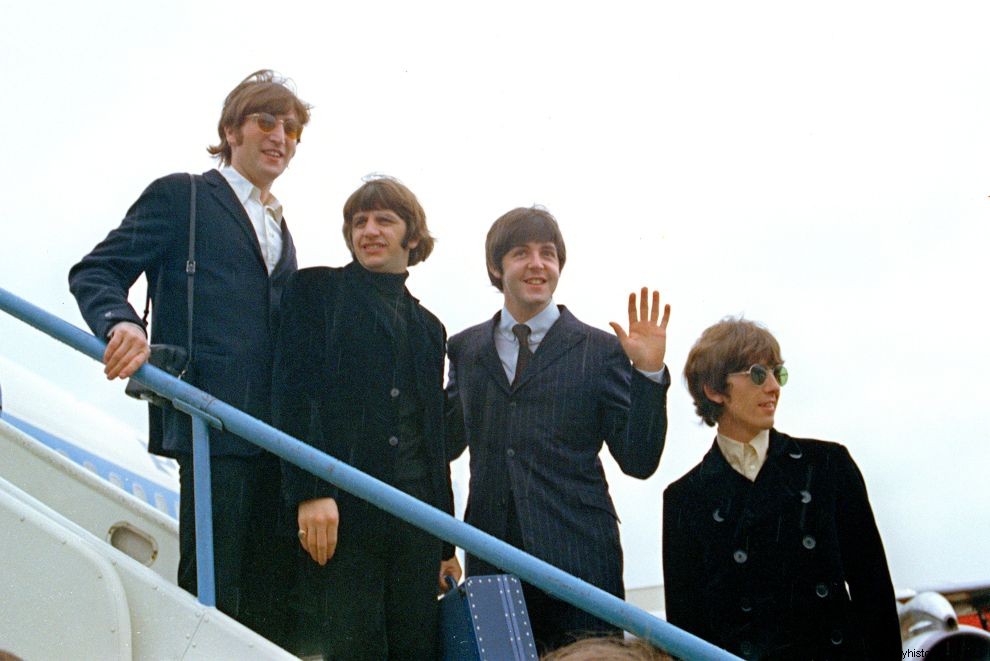
The album was a landmark of aesthetics, experimentation and enriched intelligence, one of the most important "visual" milestones of the 20th century. And it was there for the last time that the Beatles still remained a company, a company, with a clear desire to work together as musicians in every sense, in an unsurpassed mirror that reflected musical modes and places:rock, pop, art rock, psychedelia, baroque pop, hard rock, progressive rock, experimental rock, Indian music, vaudeville, everything! But, for the first time, in the same mirror were seen - still blurred - the images of their personal differences, those that in the future would make them change destinations and detour - each on their own account - from the sure avenue of "beetles".
During the recording of Pepper, we had our first disagreements about the style and what style the band should adopt next. McCartney preferred pop forms, Lennon was absorbed in introspection and experimentation, while Harrison became increasingly interested in Indian music. The "coherence" that was still present in 1967 magically disappeared completely from 1968 onwards. But another "milestone" in the Beatles' career had preceded it, perhaps the one that determined their "destiny" more than any other. On November 9, 1966, Lennon met Yoko Ono for the first time at the Indica Gallery in London. Yoko was heavily influenced by Dadaism and the Fluxus movement.
1966, LENON MEETING YOKO ONO

She herself characterized her art as avant-garde, while experimenting with various shapes on complex musical forms, mainly with synthesizers and electronic sounds. She presented various happenings, using all kinds of materials, but often became a part of her creative scenery. He also dabbled in directing, shooting experimental films and socializing with the most elite members of the avant-garde scene in New York. Lennon was fascinated by Ono's multi-faceted artistic nature, but also by her combination of Oriental origins with Western culture. The two became romantically linked in 1968, shortly after Pepper and shortly before The Beatles' ultimate masterpiece, The White Album. Her influence was so great on him that very soon she became more necessary to him than the band.
Her desire - if not her demand - to have a say in every creative moment of Lennon's - even in the band's rehearsals, something unheard of for a wife or partner of one of the members - brought the first clouds in John's relationship with Harrison, followed by McCartney. What the rest of the Beatles failed to understand was Lennon's need to veer off into even more uncharted paths that - unlike Yoko - none of them could lead him to. Music was now a tool for him to navigate underground worlds and the conflict he experienced so strongly within him was clearly seen in the Beatles' peak moment. His "hesitation" between the two versions of "Revolution" from the White Album was a microcosm of the tendency to run away that tormented him internally.
1969, LENNON SEEKS A "DIVORCE" FROM THE BEATLES

"Revolution 1" symbolized the band, the past, the legacy. Instead, "Revolution 9" captured the electric storm he felt inside, the need to follow Yoko's experimentation, to break free from what haunted and oppressed him. Dylan's lyrics, drugs and lyricism were no longer enough for him. He was looking for a new outlet. Class solidarity, political extremism, the violence of Vietnam, the paranoia that threatened his lost youth, and his spiritual commitment to continuing attempts to discover other worlds all seemed feasible only with Yoko, not the Beatles. The final blow for the other three "beetles" came in March 1969, when Lennon and Ono were married in Gibraltar.
In the meantime the Plastic Ono Band had been formed and in July "Give peace a chance" was released. A few months later, on September 20, Lennon officially announced to the remaining members of his departure from the band. But before that happened, there was another event, which also proved to be decisive for the future of the Beatles, the 1968 trip of all four to Risky. George Harrison was the first to be fascinated by the Orient. He first sought out the musical forms of India and was introduced to sitar playing by Ravi Shankar and then wanted to explore more oriental philosophy. After reading Maharishi Mahesh Yogi's book, The Science of Being and the Art of Living, he decided to visit the Hindu religious leader in India and invited the rest of the Beatles to go with him.
1968, THE MAHARISH AND THE JOURNEY TO INDIA
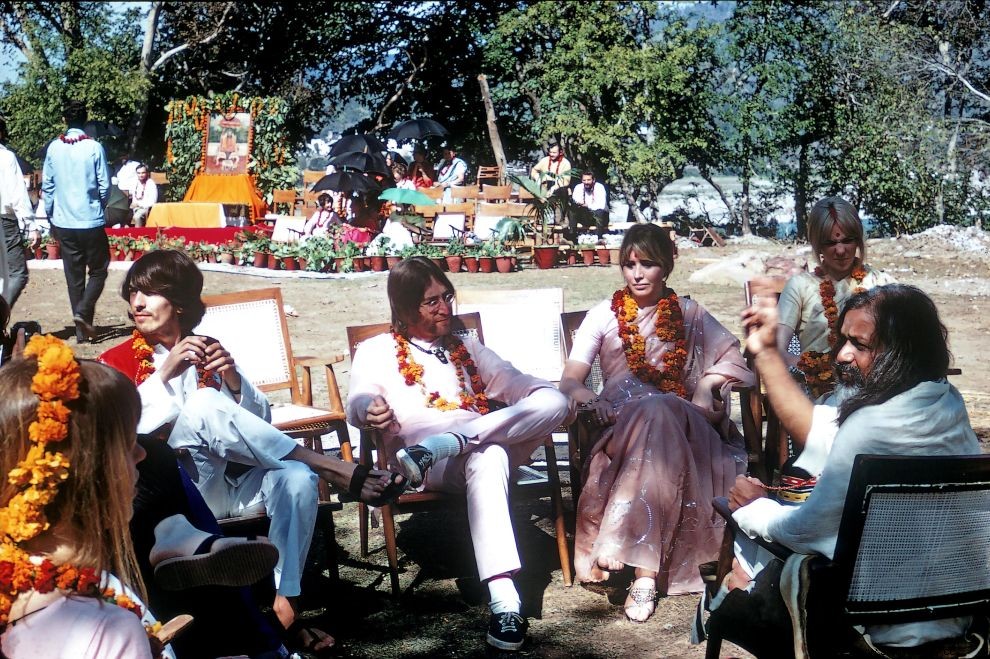
The Maharishi (1918-2008) had studied medicine and then retreated for 13 years to the Himalayas, where he studied with Guru Dev, the founder of transcendental meditation. After the death of his teacher, he created the Transcendental Meditation Movement to spread the technique of transcendental meditation around the world. Πρόκειται για ένα είδος διαλογισμού που τελείται δυο φορές την ημέρα, όπου ο διαλογιζόμενος επαναλαμβάνει νοερά ένα συγκεκριμένο "μάντρα" (ιερός ήχος ή φράση). Η συγκέντρωση στο επαναλαμβανόμενο "μάντρα" μειώνει την πνευματική ενεργητικότητα με συνέπεια την επίτευξη ενός ανώτερου σταδίου συνείδησης. Οι Μπιτλς "ασπάστηκαν" τη διδασκαλία του Μαχαρίσι, εκτός από τον Λένον, ο οποίος τον κατηγόρησε δημόσια για απρέπειες (αν και αργότερα του ζήτησε συγνώμη).
Η ουσία ήταν στο γεγονός ότι οι τέσσερις τους βρέθηκαν μακριά από τον δυτικό κόσμο για πρώτη φορά από τότε που δημιουργήθηκε το γκρουπ, κάτι που λειτούργησε ευεργετικά στον καθένα ξεχωριστά, απελευθερώνοντας όμως παράλληλα "φυγόκεντρες" δυνάμεις, οι οποίες οδήγησαν στην πρώτη μεγάλη αποξένωση των Μπιτλς. Εκείνος που επηρεάστηκε περισσότερο από το ταξίδι, ήταν - παραδόξως - ο Λένον, που παρεμπιπτόντως είχε πάει στο Ρισικές μαζί με τη σύζυγό του, Σίνθια, την οποία είχε ήδη αποφασίσει να χωρίσει. Αποτραβηγμένος από ένα σημείο και μετά από τις συζητήσεις που έκαναν οι υπόλοιποι με τον Μαχαρίσι, βρήκε μόνος του την ηρεμία και την ψυχική γαλήνη δίπλα στον Γάγγη και μπόρεσε να σκεφτεί χωρίς εξωτερικές επιρροές την γενικότερη σχέση του με την μπάντα και τη Γιόκο.
1968, ΤΟ "WHITE ALBUM"
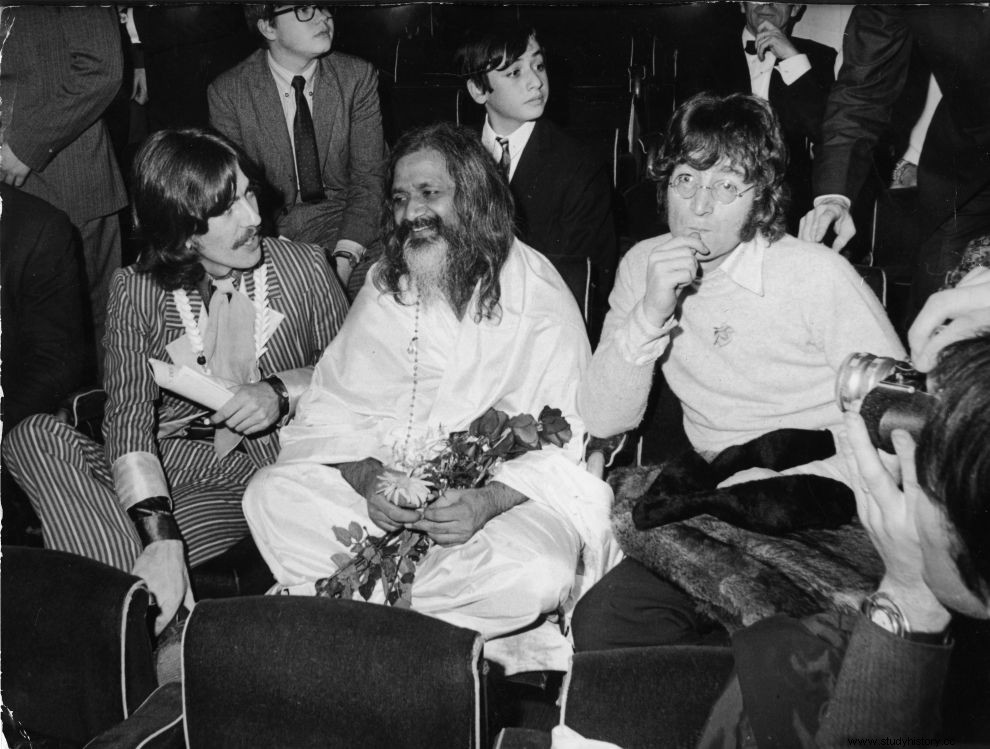
Οι λίγες εβδομάδες της παραμονής του στην Ινδία, τον έκαναν να σκεφτεί καθαρά το μέλλον του και με την βοήθεια των ναρκωτικών να "αδειάσει" το μυαλό και την ψυχή του από όλα όσα έζωναν ασφυκτικά τη ζωή του. Το Ρισικές έκανε τον Λένον να συνειδητοποιήσει ότι οι Μπιτλς είχαν τελειώσει - τουλάχιστον για αυτόν. Και όταν επικοινώνησε μετά από καιρό με τον Μαχαρίσι για να του ζητήσει συγνώμη για την αγένειά του, τον ευχαρίστησε λέγοντάς του ότι η απόσταση που δημιουργήθηκε ανάμεσα στα μέλη του συγκροτήματος στην Ινδία, ήταν αυτή που με τη σειρά της δημιούργησε το "White Album". Ο Λένον θεωρούσε πως το λευκό άλμπουμ ήταν αποτέλεσμα όχι συνεργασίας, αλλά πολυσυλλεκτικότητας. Ήταν σα να υπήρχαν δυο γκρουπ μέσα στο στούντιο, από τη μια οι τρεις Μπιτλς και από την άλλη ο ίδιος και η Γιόκο. Το παρελθόν (οι Μπιτλς), το παρόν (το White Album) και το μέλλον (η Γιόκο Όνο).
Και συνέβη πράγματι έτσι, αφού μέσα στο βινύλιο ήταν για πρώτη φορά τόσο σαφής η παρουσία "αυτόνομων" συνθέσεων και ξεχωριστών τάσεων. Το περιοδικό "Rolling Stone" είχε χαρακτηρίσει τον δίσκο ως "τέσσερα σόλο άλμπουμ κάτω από την ίδια στέγη". Ο ΜακΚάρτνεϊ είχε πει πως στη διάρκεια των ηχογραφήσεων "ήταν φανερό πως πηγαίναμε για διάλυση και αυτό φαινόταν στη συνεχή ένταση", ενώ ο Λένον είχε προσθέσει ότι "το τέλος των Μπιτλς μπορούσε να ακουστεί σε αυτό το άλμπουμ". Η συνεχής παρουσία της Όνο στο στούντιο, είχε ενοχλήσει πρώτα τον Χάρισον, που ένιωθε "προδομένος" από τον Λένον, με τον οποίο είχε "δεθεί" την προηγούμενη τριετία τόσο μέσω της χρήσης του LSD, όσο και μέσω της προσέγγισης της ινδικής πνευματικότητας. Στην εξίσωση της σύγκρουσης μπήκε και ο ΜακΚάρτνεϊ, που δεν συμφωνούσε με το πειραματικό "Revolution 9" της Γιόκο.
1969, THE ROOFTOP SESSIONS
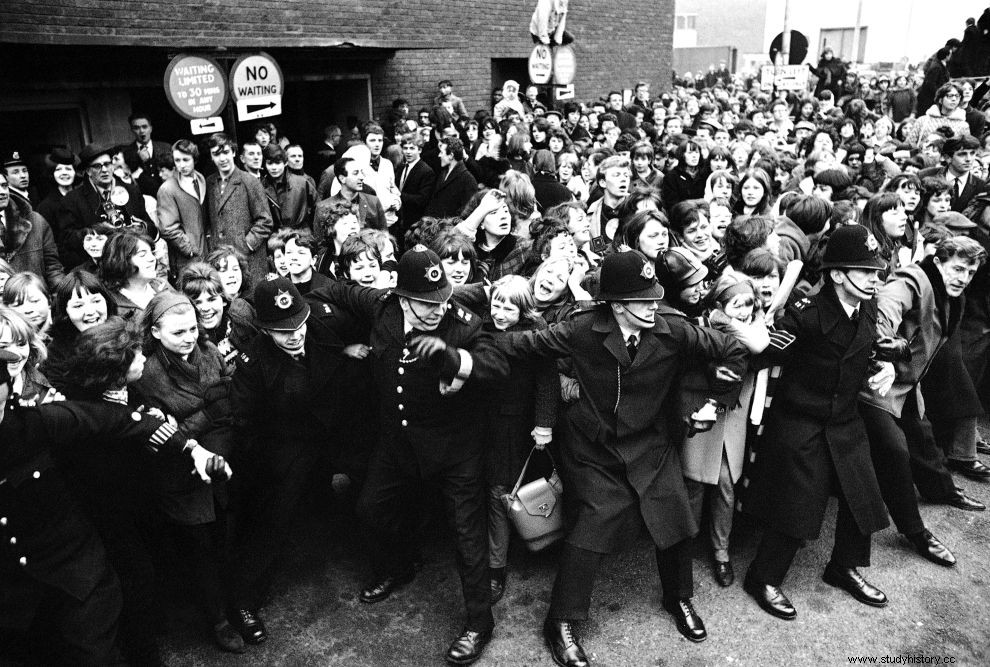
Η "απάντηση" ήρθε από τον Λένον, που με τη σειρά του, θέλησε να αποκλείσει τραγούδια του Πολ από το άλμπουμ. Και κάπου εκεί προστέθηκε και η γκρίνια του Χάρισον, που είχε αναπτυχθεί συνθετικά και απαιτούσε τον δικό του χώρο μέσα στον δίσκο. Ενδεικτικό του κακού κλίματος που επικρατούσε πλέον στις τάξεις της μπάντας, ήταν το γεγονός ότι μετά την κυκλοφορία του "White Album" τον Νοέμβριο του 1968, δεν έδωσαν ποτέ ξανά κοινή συνέντευξη Τύπου. Τα πράγματα έγιναν ακόμα χειρότερα λίγες εβδομάδες αργότερα, όταν στις 10 Ιανουαρίου του 1969, ο Χάρισον, έχοντας κουραστεί τόσο από την επιμονή του ΜακΚάρτνεϊ για επιβολή των δικών του "θέλω" στην μπάντα, όσο και από την ολοένα αυξανόμενη αποξένωση του Λένον (που είχε πέσει με τα μούτρα στην ηρωίνη), ανακοίνωσε πως εγκατέλειπε τους Μπιτλς.
Οι υπόλοιποι τρεις μπορεί τελικά να τον έπεισαν να παραμείνει, όμως το γυαλί είχε ραγίσει ανεπανόρθωτα. Λίγες μέρες μετά, στις 30 Ιανουαρίου, τα "σκαθάρια" έπαιξαν για τελευταία φορά ζωντανά, στην ιστορική τους εμφάνιση στο κτίριο του Apple Corps. Λίγο πριν το μεσημέρι και χωρίς να έχει προγραμματιστεί από πριν, οι Μπιτλς μαζί με τον κιμπορντίστα Μπίλι Πρέστον, αλλά και την άγρυπνη παρουσία της Όνο, ανέβηκαν στην ταράτσα του κτιρίου - όπου υπάλληλοι της Apple είχαν ήδη τοποθετήσει όργανα και ενισχυτές - και άρχισαν να κουρδίζουν. Οι κάμερες στήθηκαν και μπροστά σε λίγους τυχερούς - αφού το κοινό δεν είχε ενημερωθεί - οι "Fab Four" πραγματοποίησαν το τελευταίο τους live, που διήρκεσε 42 λεπτά και στο οποίο έπαιξαν το "Get back" (τρεις φορές), το "Don't let me down" (δυο φορές), το "I've got a feeling" (δυο φορές), το "One after 909" και το "Dig a pony".
1969, ΑΛΕΝ ΚΛΑΪΝ VS ΛΙ &ΤΖΟΝ ΙΣΤΜΑΝ

Στο ξεκίνημα του 1969 προέκυψε ένα καινούργιο πρόβλημα ανάμεσα στα μέλη του συγκροτήματος, που προκάλεσε ακόμα μεγαλύτερη επιδείνωση στις σχέσεις τους. Η Apple Corps, η εταιρεία των Μπιτλς που είχε ιδρυθεί τον Ιανουάριο του 1968, ήταν ουσιαστικά ακέφαλη, έτσι λοιπόν, τον Ιανουάριο του 1969, ο Λένον και η Όνο προσέγγισαν τον Άλεν Κλάιν, επιχειρηματία και ιδρυτή της ABKCO Records (μεγάλης ανεξάρτητης δισκογραφικής εταιρείας), για να του ζητήσουν να αναλάβει την εκπροσώπηση των συμφερόντων του Τζον στην μπάντα. Από την άλλη μεριά, ο ΜακΚάρτνεϊ ανάθεσε τη δική του εκπροσώπηση στους δικηγόρους Λι και Τζον Ίστμαν, πατέρα και αδερφό της συντρόφου του, Λίντα Ίστμαν (την οποία νυμφεύθηκε τον Μάρτιο της ίδιας χρονιάς). Τελικά, μετά από αρκετές θυελλώεδεις συναντήσεις ανάμεσα στον Κλάιν, τους Ίστμαν και τους Μπιτλς, επήλθε συμφωνία.
Ο μεν Κλάιν θα αναλάμβανε το πόστο του επιχειρηματικού διευθυντή, ενώ οι Ίστμαν θα ήταν οι νομικοί σύμβουλοι του συγκροτήματος. Πολύ σύντομα όμως, οι διαφωνίες ανάμεσα στον Κλάιν και τους Ίστμαν έγιναν αξεπέραστες και οι δυο "ουδέτεροι", Χάρισον και Σταρ, αποφάσισαν να συνεχίσουν με τον πρώτο. Οι Ίστμαν απολύθηκαν από την τριπλή πλειοψηφία (Λένον, Χάρισον, Σταρ) και αυτό, όπως ήταν αναμενόμενο, έκανε ακόμα μεγαλύτερο το χάσμα, με την εμπιστοσύνη και τη συναδελφικότητα να έχουν εξαφανιστεί πλέον από την τετράδα. Στο μεταξύ, ενώ η τελευταία τους δουλειά, το άλμπουμ "Get back", που τελικά μετονομάστηκε σε "Let it be", είχε σχεδόν ηχογραφηθεί ολόκληρο, οι Μπιτλς αποφάσισαν να βάλουν μπροστά τη δημιουργία ενός ακόμα δίσκου, του περίφημου "Abbey Road", ή αν το προτιμάτε, της πιο διάσημης "διάβασης" στην ιστορία της μουσικής.
1969, ΤΟ "ABBEY ROAD"
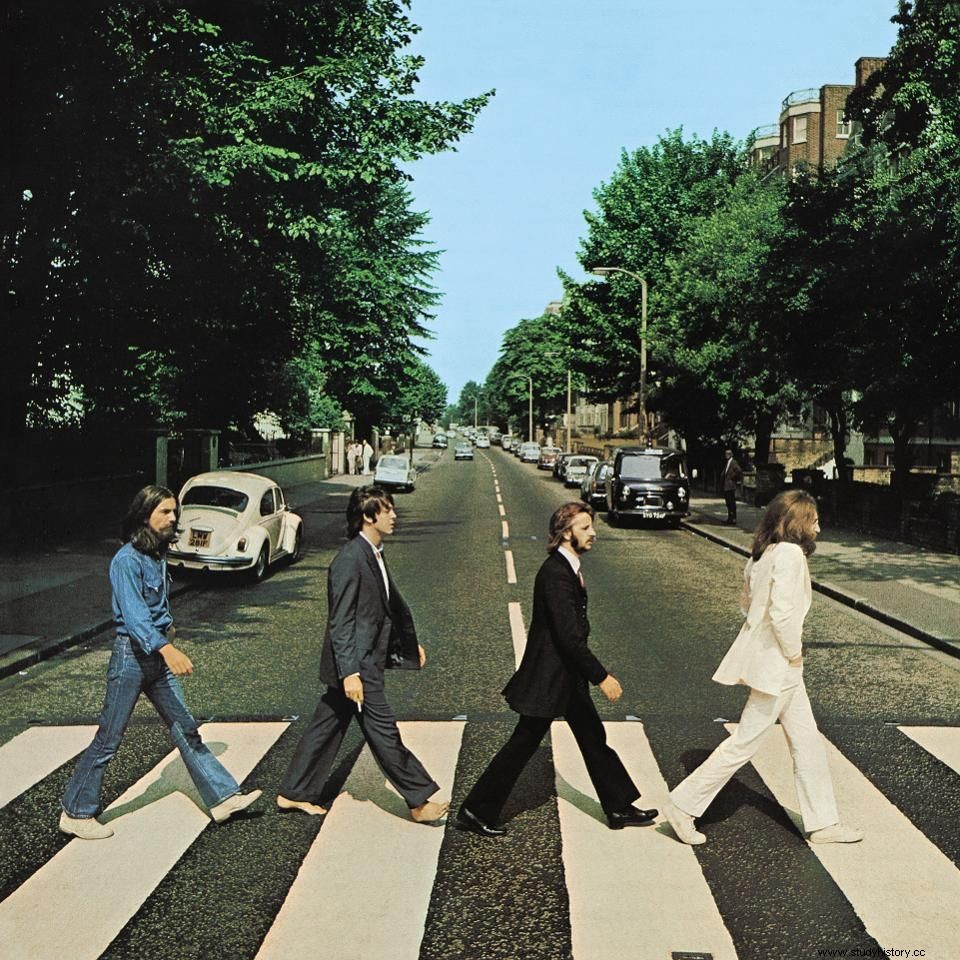
Λίγο πριν την οριστική διάλυση, τα "σκαθάρια" έσμιξαν για μια τελευταία μεγάλη περιπλάνηση, η αφήγηση της οποίας πέρασε μέσα από τον εσωτερικό μονόλογο του καθενός τους, οδηγώντας στη "ροή της συνείδησης" όπου περίμενε η κάθαρση. Η τελευταία στροφή πριν την τελική ευθεία, αποδείχτηκε ένα ακόμη μνημείο έμπνευσης, περιπέτειας και ενδοσκόπησης. Για τη δημιουργία του άλμπουμ χρειάστηκε μια μικρή ανακωχή, όμως, έστω και για λίγο, οι Μπιτλς μπήκαν στα θρυλικά στούντιο της Abbey Road για να μεγαλουργήσουν ξανά, αυτή τη φορά φτάνοντας στη δημιουργία μέσα από μόνιμες διαφωνίες σε μια καταδικασμένη διαλεκτική "μάχη", μόνο και μόνο για να απεγκλωβίσουν για μια τελευταία φορά την έμπνευσή τους μέσα από κάθε φορμαλιστικό και επιτηδευμένο περίβλημα.
Η αισθητική τους άποψη - όσο και αν μεταξύ τους ήταν τελείως αποκομμένοι - ανακάλυψε καινούργια μονοπάτια εντελώς απροσδόκητα και τολμηρά, γκρεμίζοντας κάθε απροσπέλαστο "αξίωμα", για να προσθέσει έναν ακόμα ογκόλιθο στη μυθολογική τους επιρροή. Μέσα στο "Abbey Road", οι Beatles επινόησαν και πάλι - για πολλοστή φορά - τον εαυτό τους. Δεν υπήρχε κάποια συγκεκριμένη φόρμα που να κυριαρχεί μέσα στα αυλάκια του βινύλιου, αφού οι Μπιτλς φρόντισαν να χτίσουν - για μια ακόμη φορά - έναν πολυσύνθετο χώρο, μέσα στον οποίο τοποθέτησαν ονειρικές αρμονίες σε κάθε γνωστή διάσταση:pop, rock, art rock, progressive rock, blues, music hall, hard rock, rock 'n roll, folk rock, ψυχεδέλεια, συμφωνικό rock. Οι "κοσμικές" ενορχηστρώσεις του Τζορτζ Μάρτιν απογείωσαν το τελικό αποτέλεσμα με τη χρήση - εκτός των άλλων - του Moog synthesizer και του Leslie speaker.

Στις 18 Αυγούστου του 1969, ήταν η τελευταία φορά που η τετράδα ηχογράφησε μαζί. Επρόκειτο για το προφητικό "The End", τον "τέλειο επιτάφιο στην επίσκεψή μας στον κόσμο των ονείρων των Μπιτλς", όπως χαρακτηριστικά είχε γράψει ο Τζον Μέντελσον στο "Rolling Stone". Δυο μέρες μετά, στις 20 Αυγούστου, ήταν η τελευταία φορά που οι "Fab Four" βρέθηκαν μαζί σε ένα στούντιο, στο μιξάρισμα του "I want you (She's so heavy)". Στις 8 Σεπτεμβρίου, οι ΜακΚάρτνεϊ, Λένον και Χάρισον, συναντήθηκαν για να συζητήσουν την πιθανότητα ηχογράφησης ενός ακόμα άλμπουμ. Εκεί, οι Τζον και Τζορτζ πρότειναν την εκπροσώπηση συνθέσεων και από τα τέσσερα μέλη στον δίσκο, ενώ ο Λένον ζήτησε να καταργηθεί το κυρίαρχο μέχρι τότε μοτίβο του δίδυμου McCartney-Lennon.
Ο ΜακΚάρτνεϊ αρνήθηκε - προς μεγάλη απογοήτευση των άλλων δυο - λέγοντας ότι αυτή η πρόταση δεν είχε ισορροπία και πως "παραήταν δημοκρατική για το καλό της", ενώ δε δίστασε να προσθέσει πως τα τραγούδια του Χάρισον πριν το "Abbey Road" δεν ήταν κάτι το ιδιαίτερο, για να εισπράξει την απάντηση του Λένον, ότι το "Obladi Oblada" και το "Maxwell's Silver Hammer" (αμφότερα συνθέσεις του Πολ) δεν άρεσαν σε κανέναν άλλο στην μπάντα και κανονικά θα έπρεπε να έχουν δοθεί σε άλλους καλλιτέχνες για να ηχογραφηθούν! Δώδεκα μέρες αργότερα, ο Λένον, απογοητευμένος από την αμετακίνητη στάση του Πολ, ζήτησε το "διαζύγιο" από το συγκρότημα, βάζοντας ουσιαστικά τέλος στους Μπιτλς, με την αυλαία να πέφτει και τυπικά στις 9 Απριλίου του 1970, όταν ο ΜακΚάρτνεϊ ανακοίνωσε τη δική του αποχώρηση από τα "σκαθάρια".
1970, ΠΡΟΒΛΗΜΑΤΑ ΚΑΙ ΜΕ ΤΟ "LET IT BE"

Ο Πολ, αμέσως μετά την απόφαση του Λένον να αφήσει το γκρουπ, αποσύρθηκε μαζί με την οικογένειά του στο κτήμα του στη Σκωτία, κυριολεκτικά διαλυμένος ψυχολογικά και με σημάδια βαθιάς κατάθλιψης από την τροπή που είχαν πάρει τα πράγματα. Όταν στο τέλος του Οκτωβρίου του 1969, τον ανακάλυψαν ρεπόρτερ του περιοδικού "Life" για να δουν αν αλήθευαν οι φήμες περί θανάτου του, εκείνος τους είπε κάποια στιγμή "το πράγμα με τους Μπιτλς έχει τελειώσει", χωρίς όμως να δοθεί η απαιτούμενη βαρύτητα στη δήλωσή του. Στις αρχές του Γενάρη του 1970, ο ΜακΚάρτνεϊ επέστρεψε στο Λονδίνο για να ολοκληρώσει μαζί με τους Χάρισον και Σταρ την ηχογράφηση του "Let it be", όμως στη συνέχεια προέκυψε και άλλο πρόβλημα. Οι Τζον, Τζορτζ και Ρίνγκο κάλεσαν τον παραγωγό Φιλ Σπέκτορ για να επιμεληθεί την τελική παραγωγή του άλμπουμ, χωρίς όμως να ενημερώσουν τον Πολ.
Όταν το πληροφορήθηκε, έγινε έξαλλος και άρχισε να ανταλλάσσει επιστολές με τον Σπέκτορ, απορρίπτοντας κάθε παρέμβασή του στα τραγούδια του δίσκου. Τότε ήταν που έμαθαν οι Λένον, Χάρισον και Σταρ, ότι ο ΜακΚάρτνεϊ σκόπευε να παρουσιάσει επίσημα το παρθενικό σόλο άλμπουμ του, "McCartney" στις 17 Απριλίου, λίγες μόλις μέρες πριν την - από καιρό προγραμματισμένη - κυκλοφορία από την Apple τόσο του "Let it be" όσο και του "Sentimental Journey", του σόλο άλμπουμ του Ρίνγκο. Στις 31 Μαρτίου, ο Σταρ επισκέφθηκε τον Πολ και του ζήτησε να αναβάλλει την κυκλοφορία του "McCartney", όμως ο ΜακΚάρτνεϊ αντέδρασε πολύ άσχημα, διώχνοντας τον Ρίνγκο από το σπίτι του και αρνούμενος να δεχτεί οποιαδήποτε αλλαγή ημερομηνίας. Εκεί ήταν που ο Πολ πήρε την τελική απόφαση να φύγει από τους Μπιτλς.
ΟΙ ΑΝΤΙΔΡΑΣΕΙΣ ΧΑΡΙΣΟΝ ΚΑΙ ΛΕΝΟΝ

Διαβάσατε στην αρχή του κειμένου για τη συνέντευξη Τύπου που δόθηκε στις 9 Απριλίου από τον ΜακΚάρτνεϊ, αλλά και τον κόσμο που συγκεντρώθηκε την επόμενη μέρα έξω από τα γραφεία της Apple Corps, περιμένοντας να μάθει αν ίσχυαν όσα είχε πει ο Πολ περί αποχώρησής του από το γκρουπ και διάλυσης των Μπιτλς. Εκείνη την ίδια μέρα (10/4), μέσα στο κτίριο της Apple βρισκόταν ο Χάρισον, που έκανε ένα γύρισμα για το BBC, όμως αρνήθηκε να μιλήσει στους δημοσιογράφους. Ο Ρίνγκο περιορίστηκε σε ένα απλό "πρώτη φορά το ακούω", ενώ ο Λένον, πολύ πιο καυστικός και ειρωνικός, δήλωσε:"Είναι πολύ ευχάριστο το ότι μάθαμε πως είναι ακόμα ζωντανός. Πάντως, μπορείτε να πείτε ότι είπα αστειευόμενος, πως δεν εγκατέλειψε το γκρουπ, αλλά ότι εγώ τον απέλυσα". Η αλήθεια είναι πως οι Τζον, Τζορτζ και Ρίνγκο ένιωθαν προδομένοι από την ανακοίνωση του Πολ.
Σε μια συνέντευξή του στο "Rolling Stone" την εβδομάδα που ακολούθησε, ο Λένον το "τράβηξε" ακόμα περισσότερο, λέγοντας:"Όλο αυτό είναι απλώς ο ΜακΚάρτνεϊ που προκαλεί χάος, με τον ίδιο τρόπο που κατέβαζε μούτρα όταν ο Έπσταϊν δεν έκανε το δικό του". Και συμπλήρωσε:"Το καρτούν είναι το εξής:τέσσερις τύποι σε μια σκηνή με έναν προβολέα πάνω τους. Δεύτερη εικόνα, τρεις τύποι σε μια σκηνή που σβήνουν από τον προβολέα. Τρίτη εικόνα, ένας τύπος στέκεται εκεί φωνάζοντας 'φεύγω'". Η πιο συγκλονιστική φράση όμως που ακούστηκε, ήταν εκείνη στο CBS News:"Η στιγμή είναι τόσο σημαντική, ώστε κάποια μέρα, οι ιστορικοί, θα τη βλέπουν ως ένα ορόσημο στην πτώση της Βρετανικής Αυτοκρατορίας. Οι Μπιτλς διαλύονται". Τα υπόλοιπα τρία "σκαθάρια" πάντως, διατηρούσαν ελπίδες για τη συνέχεια της μπάντας.
Ο Χάρισον, σε μια συνέντευξη που έδωσε στο τέλος Απριλίου στη Νέα Υόρκη, δήλωσε ότι "θα είναι πολύ εγωιστικό αν οι Μπιτλς δεν παραμερίσουν τις διαφορές τους και δεν ηχογραφήσουν σύντομα ξανά μαζί, με δεδομένο το πόσα σημαίνει για τους ακροατές η μουσική τους". Ο Τζορτζ πρόσθεσε ότι "ο ΜακΚάρτνεϊ δεν μπορεί να δεχτεί πως πλέον έχει λιγότερο έλεγχο πάνω στο γκρουπ. Για εμάς τους υπόλοιπους, οι Μπιτλς και η Apple βρίσκονται πιο πάνω από το τί θέλουν ο Πολ και τα πεθερικά του". Ακόμα και ο ίδιος ο αποστασιοποιημένος Λένον, είχε δηλώσει τότε πως τον ενδιέφερε σαφώς να ηχογραφήσει ξανά μαζί με τους Μπιτλς, καταλήγοντας:"Θα μπορούσε να είναι μια αναγέννηση ή ένας θάνατος. Θα δούμε τί από τα δυο θα γίνει, πιθανότατα όμως πιστεύω ότι θα πρόκειται για αναγέννηση".
51 ΧΡΟΝΙΑ ΜΕΤΑ, ΤΟ "ΘΑΥΜΑ" ΣΥΝΕΧΙΖΕΙ ΝΑ ΜΑΓΕΥΕΙ

Τελικά ήταν "θάνατος". Οι Μπιτλς δεν ξαναβρέθηκαν ποτέ μαζί σε ένα στούντιο ή σε μια συναυλία, για την ακρίβεια, ποτέ δεν ξανασυναντήθηκαν και οι τέσσερις μαζί σε οποιαδήποτε περίσταση. Υπήρξαν αρκετές συνεργασίες ανάμεσά τους, αλλά πάντοτε με τους δυο ή τους τρεις παρόντες. Πολλοί μάνατζερ και παραγωγοί προσπάθησαν να δελεάσουν - κυρίως χρηματικά - την τετράδα για ένα reunion, όμως αποδείχτηκε αδύνατο. Όλοι συνέχισαν τις σόλο καριέρες τους, αφήνοντας πίσω τους μια βελούδινη νοσταλγία για εκείνη την υπέροχη δεκαετία, στη διάρκεια της οποίας πρόλαβαν να γίνουν αξεπέραστοι από οτιδήποτε και οποιονδήποτε. Πενήντα ένα χρόνια μετά τη διάλυσή τους, η κληρονομιά τους παραμένει ζωντανή, μέσα από την τελειότερη μουσική αφήγηση που υπήρξε ποτέ, καταργώντας τα σύνορα ανάμεσα στην τέχνη και τη ζωή.
Οι Μπιτλς μας επέτρεψαν να βιώσουμε την πεμπτουσία της έντασης και της αρμονίας. Της επιθυμίας και της μελωδίας. Της δημιουργίας και της πολυμορφίας. Της σύγκρουσης και της πρωτοτυπίας. Του πειραματισμού και της αμφισβήτησης. Του πυρήνα και της έκρηξης. Της περιπέτειας και της μαρτυρίας. Η πορεία τους υπήρξε ένας ολοκληρωτικός, σαρωτικός, μεθυστικός θρίαμβος μουσικής ευφυΐας, ενέργειας και αισθητικής. Η τετράδα που έδειξε την ηχητική αλήθεια μέσα από το συνεχές "σοκ" των "κλεμμένων" στιγμών της ψυχής και του σώματος κάθε νότας, κάθε ακόρντου, κάθε κλειδιού, κάθε πεντάγραμμου και κάθε παρτιτούρας. Γιατί, όπως γράψαμε και στην αρχή του κειμένου, τα "σκαθάρια" δεν υπήρξαν απλά μια μπάντα, αλλά ένα θαύμα. Και μέσα από το έργο τους μπόρεσαν να ταυτιστούν με την ίδια την αγάπη για τη μουσική.
